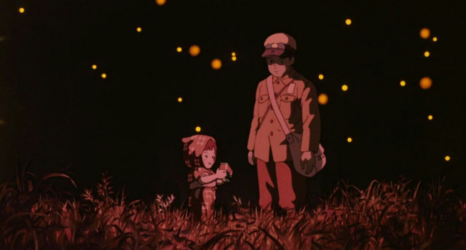Of course, the only correct reaction after seeing this Isao Takahati/Studio Ghibli film, possibly the saddest movie ever made is:
“And that’s what you get for bombing Pearl Harbor!”

Pictured: The fire-bombing of Osaka.
The Japanese are funny. Not just funny ha-ha, because they are that, but also funny strange, which is such an obvious statement as to be a cliché at this point. But setting aside the weird cultural diversions they are famous for, and their inability to reproduce—which is probably the direct result of our wrecking their culture after WWII—they seem to have avoided the Western world’s self-flagellation.
That is to say, while I have seen many Japanese films about WWII, I have yet to see one from Japan that admits to any culpability outside of the generic “War is Bad” stuff. This creates an interesting situation where, for example, we have sympathy when our heroine in In This Corner of the World, when she rages that all her sacrifices were for nothing because Japan lost the war. And in The Wind Rises for the designer of the Zero—a plane used to kill many Americans—because he just wanted to make planes.
I’m not really making a judgment here. If there’s anything easier than virtue signalling about genocide, I’m not sure what it is. And I’m not sure it’s healthy the way the Germans, the French, the Italians, etcetera, beat themselves up over WWII, though this does absolutely nothing to curb their modern anti-semitism. (The Russians don’t seem do this, probably because it was the Soviets that sowed the seeds of guilt in the west after WWII.) I do wonder about the effect on the post-war Japanese, who seem to believe the United States dropped the A-Bomb on them on a lark. (In Corner, there’s a kind of echo of the sentiment “How dare they surrender while any Japanese are still living!”)

She’s gonna be fine, right?
But the attitude gives us a perspective which is perhaps truer to life: Namely, people tend to root for a particular side without necessarily any way to know what’s going on. I think the only film I know of that shows the insanity of Japan at the end of the war is Eastwood’s Letters from Iwo Jima. But when a government (and its fellow travelers—kaff) completely controls the media and culture, you can have both situations: That is, one where people running up against the edge of the crazy experience it in full force while those who can’t even believe such things are going on.
Which brings us to this sad and beautiful film about two orphaned children starving to death in the final days of the war. Because who knows less about what’s going on, and is impacted more, than orphaned children? The movie begins with Seita, the narrator, starving to death in a train station, as various Japanese adults ignore him, and American soldiers distribute food. The rest of the movie is in flashback, where he describes his (failed) struggle to keep his baby sister Setsuko alive.
Not exactly “Heidi: Girl of the Alps” (one of the TV shows Takahata worked on before Ghibli).

An actual firebombing. Say, I wonder if that’s meant to be a parallel?
It’s a touching story, obviously. It doesn’t really have to try hard: Just about any kids struggling to survive in this context would be touching. What surprised me in this context (seeing it again after only seeing it on video a couple of decades ago) was that it isn’t that this movie wallows in suffering, as sometimes happens with sad films. It’s basically a kind of coming-of-age story for Seita, where he, you know, doesn’t actually get the opportunity to come of age.
But their journey is charming in the way of a lot of kid’s adventure stories. If not for, you know, the malnutrition and the ending, you could easily see it being a kind of Pippi Longstocking thing. And the author of the original novel has said that it’s not meant as an anti-war treatise at all, but as an apology to his late sister.
This rescues it from the triteness of being merely “anti-war”: Seita’s pride ultimately results in his sister’s (and his own) death—somethign I hadn’t realized the first time I saw this but was inescapable now. He can’t stand his shrew of an aunt, who’s using his and Setsuko’s food to feed her own family, while constantly berating the two of them for not helping, and further chastising Setsuko for having nightmares about her recently deceased mother. She doesn’t really run them off; rather Setsuko runs away with Seita, envisioning an idealized world with just the two of them.
This, as I say, makes a far more powerfully poignant and heart-wrenching story than “Oh, war is bad, and bad things happen to kids in war.”
I brought Kleenex. I didn’t need them (much) but that’s because…uh…I’m really strong and not susceptible to this sort of thing. Honest. The kids loved it, of course, even with the Flower’s reservations seeing it. (She had also seen it on video when she was way too young.) One of my co-workers came and cried with us, which was sweet. (She was missing her own kid, who was off with her father.)
Beautiful film, but it’ll rip your heart out.

She’s gonna be fine RIGHT?!?!
